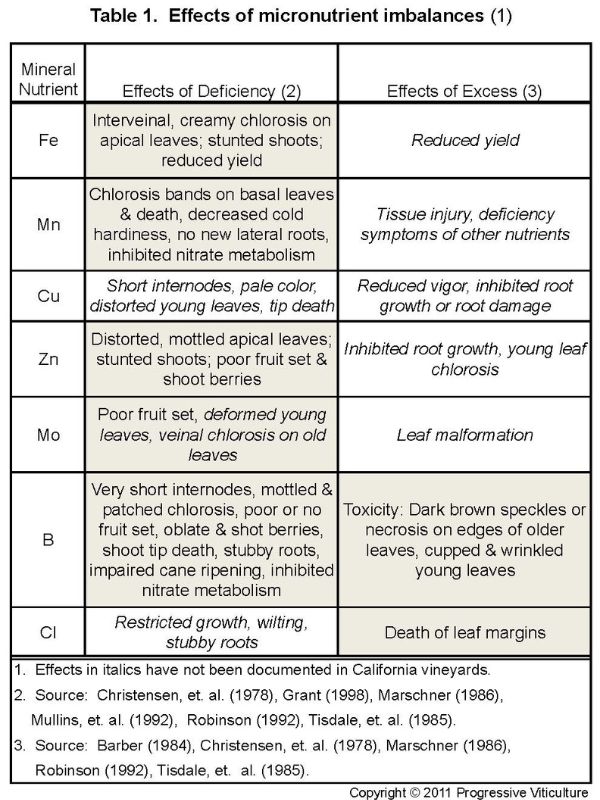 Micronutrients are mineral elements required in small quantities by plants for normal growth and development. They include iron, manganese, copper, zinc, boron, molybdenum, and chloride. The micronutrients tend be overshadowed by the macronutrients, especially nitrogen and potassium, in the minds of many of us in the wine grape industry. In fact, micronutrients are often referred to as “minors”. With regard to grapevines, however, there is nothing minor about them. Small fluctuations in their supply in vineyards can have profound consequences for vines (table 1). Though their presence is small, they are mighty in effect.
Micronutrients are mineral elements required in small quantities by plants for normal growth and development. They include iron, manganese, copper, zinc, boron, molybdenum, and chloride. The micronutrients tend be overshadowed by the macronutrients, especially nitrogen and potassium, in the minds of many of us in the wine grape industry. In fact, micronutrients are often referred to as “minors”. With regard to grapevines, however, there is nothing minor about them. Small fluctuations in their supply in vineyards can have profound consequences for vines (table 1). Though their presence is small, they are mighty in effect.
In addition to relative quantities, the micronutrients differ from the macronutrients in their functions in grapevines. With the exception of potassium, most macronutrients have structural functions, either in large molecules or in tissues. In contrast, micronutrients mainly serve as activators and cofactors for vine metabolism and cell function. These include roles in basic processes, like photosynthesis, as well as roles in secondary metabolism, including the synthesis of pigments (anthocyanins) in the skins of red-colored berries and the formation of woody tissues (lignification). For instance, poor fruit color and winterkill of canes are sometimes associated with boron deficiency.
This article was originally published in the Mid Valley Agricultural Services March 2011 newsletter.
Deficiencies of micronutrients induce foliar symptoms in grapevines that reflect their functions and may include distinct patterns of leaf yellowing (chlorosis), shoot and/or leaf distortion, and poor set and misshapen berries (figures 1-5).

Figure 1. Young shoots displaying the creamy chlorosis symptoms of iron deficiency in Pinot Gris. (Source: Progressive Viticulture, LLC ©)
Because some micronutrients are involved in the uptake and translocation of other mineral nutrients, a specific micronutrient deficiency may cause a secondary nutrient deficiency.
For example, boron deficiency inhibits nitrate uptake and sometimes induces nitrogen deficiency in grapevines. In some situations, certain micronutrients, such as boron and chloride, may accumulate in leaves to toxic levels, causing damage or death to their edges (margins).
In soils, micronutrients for vine use come mainly from the primary minerals within the mineral matrix. Organic matter may also be a source of copper, zinc, molybdenum, and boron. These combined sources normally contain an abundance of micronutrients, with the exception of chloride. There are no native sources of chloride in soils, but chloride from irrigation water, fertilizers, and air pollution is normally sufficient to meet vine needs. The relative abundance of sources in the soil, however, is not the end of the micronutrient supply story.
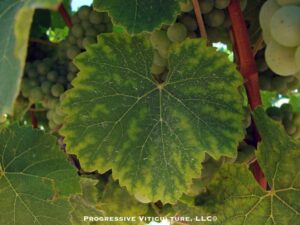
Figure 2. The herringbone pattern of leaf chlorosis due to manganese deficiency in Riesling. (Source: Progressive Viticulture, LLC ©)
As primary minerals weather and organic matter decomposes, micronutrients are released into the soil solution where several possible fates await them. For vineyard managers, the best possible outcome is uptake by grapevines, a cover crop, or soil microorganisms. Another favorable outcome is adsorption onto the surfaces of soil particles, where they serve as a reserve supply. Alternatively, micronutrients may be carried (leached) below the root zone with downward percolating water. Depending on the soil chemical environment (pH), they may also precipitate in solid compounds or become firmly adsorbed onto surfaces of certain oxide minerals, becoming unavailable to vines. Due to such reactions, iron, manganese, copper, and zinc are commonly low in strongly alkaline soils and molybdenum is typically low in strongly acid soils. Root zone environmental conditions that inhibit root growth and function, such as cool temperatures, too little or too much soil moisture, and compaction, also limit a vine’s access to micronutrients and their ability to take them up.
In addition to supply and acquisition factors, micronutrient demand variables exist in vineyards. Some varieties are prone to certain micronutrient deficiencies, such as boron deficiency in Zinfandel and zinc deficiency in Mourvedre. Moreover, rootstocks may be prone to micronutrient deficiencies. Freedom is commonly associated with zinc deficiency and 3309 is prone to iron deficiency. For virtually all combinations of varieties and rootstocks, even for vineyards with an abundance of available micronutrients in the soil, the risk for some micronutrient deficiencies is high during the short transitions between extended phenological stages (i.e. bloom and veraison). For this reason, many vineyards achieve fruit set benefits from foliar applications of boron and zinc during bloom.
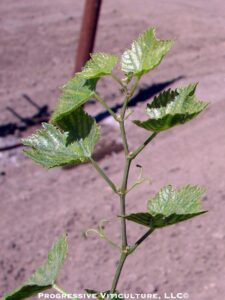
Figure 3. Stunted shoot, deformed leaves, and banded faded chlorosis leaf symptoms of zinc deficiency in Pinot Noir. (Source: Progressive Viticulture, LLC ©)
As mentioned above, micronutrient deficiencies induce distinctive foliar symptoms. Relying solely on visual symptoms to manage micronutrients, however, is highly inefficient because significant harm occurs before they become visible. Fortunately, with the possible exception of iron, tissue analysis is useful for monitoring grapevine micronutrient status prior to symptom development, as well as confirming them after they appear. In addition, soil analysis is helpful for monitoring changes in the micronutrient supply and chemical factors that affect it.
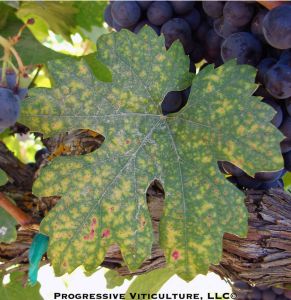
Figure 4. Mottled chlorosis leaf symptoms of boron deficiency in Zinfandel. (Source: Progressive Viticulture, LLC ©)
Micronutrients are easy and given the small quantities involved, inexpensive to manage.
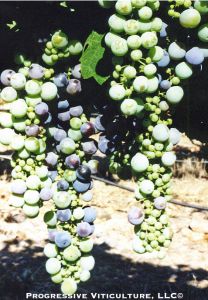
Figure 5. Poor fruit set and undersized, oblate berry symptoms of boron deficiency in Zinfandel. (Source: Progressive Viticulture, LLC ©)
Foliar fertilization is highly effective in meeting the very high transient micronutrient demand during bloom and veraison, while fertigation is effective for satisfying non-peak demand. Several fertilizer formulations are available for iron, manganese, copper, and zinc that vary in cost and effectiveness, including formulations acceptable for organic wine grapes. While there are fewer options for molybdenum and boron, most formulations are highly efficacious. Still, where soil boron is very low, multiple fertilizer applications by a number of methods may be required to avoid deficiencies in vines.
Further Reading:
Christensen, LP; Kasimatis, AN; Jensen, FL. Grapevine nutrition and fertilization in the San Joaquin Valley. Univ. Calif. Div. Agric. Sci. 1978.
Christensen, LP; Beede, RH; Peacock, WL. Fall foliar sprays prevent boron-deficiency symptoms in grapes. California Agriculture. 60, 100-103. Apr-Jun 2006.
Cook, JA; Wheeler, DW. Use of tissue analysis in viticulture. In Soil and plant tissue testing in California. Reisenhauer, HM (ed). Univ. Calif. Div. Agric. Sci. Bulletin 1879. 1983.
Marshner, H. Mineral nutrition of higher plants. Academic Press, London. 1986.
Mortvedt, JJ; Cox, FR; Shuman, LM; Welch, RM. Micronutrients in agriculture. Soil Science Society of America, Madison, WI. 1991.
Tisdale, S. L., W. L. Nelson, and J. D. Beaton. Soil fertility and fertilizers. 4th Ed. Macmillan Publishing Company, New York. 1985.
Winkler, AJ; Cook, JA; Kliewer, WM; Lider, LA. General viticulture. Univ. Calif., Berkeley. 1974.

